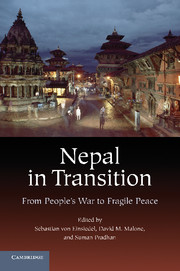Book contents
- Frontmatter
- Contents
- Contributors
- Acknowledgments
- 1 Introduction
- The Context
- Critical Transition and the Role of Outsiders
- Regional Dynamics
- 11 A Yam between Two Boulders: Nepal's Foreign Policy Caught between India and China
- 12 Bringing the Maoists down from the Hills: India's Role
- 13 A Nepali Perspective on International Involvement in Nepal
- Conclusions
- Index
- References
12 - Bringing the Maoists down from the Hills: India's Role
Published online by Cambridge University Press: 05 April 2012
- Frontmatter
- Contents
- Contributors
- Acknowledgments
- 1 Introduction
- The Context
- Critical Transition and the Role of Outsiders
- Regional Dynamics
- 11 A Yam between Two Boulders: Nepal's Foreign Policy Caught between India and China
- 12 Bringing the Maoists down from the Hills: India's Role
- 13 A Nepali Perspective on International Involvement in Nepal
- Conclusions
- Index
- References
Summary
The transition of Nepal's Maoist insurgency into a peaceful democratic process in 2006 has been one of the most remarkable developments in the history of efforts to resolve communist rebellions. Peaceful resolutions of insurgencies are not entirely new in South Asia. The Tamil, Punjabi, and Assam separatist movements in India and the Sindhi agitation for identity assertion in Pakistan are other examples. However, the case of a left extremist insurgency joining hands with bourgeoisie parties to resolve a 10-year-old violent conflict has rarely been seen. Yet, the Maoists of Nepal transformed their violent People's War and agreed to confront the monarchist state through peaceful civil agitation in alliance with the established mainstream political parties. The People's Movement, or Jana Andolan II, launched by the mainstream parties and the Maoists against the monarchy, was ultimately the product of various forces coming together in reaction to the royal coup of February 2005. The alliance between the Maoists and the mainstream parties was also greatly facilitated and influenced by the international community, especially India. In this role, India gradually changed its position from that of supporting the monarchy against the Maoist insurgency to favoring an alliance between the Maoists and the political parties to marginalize the monarchy. In doing so, India acted indirectly but in concert with other members of the international community and, through the Nepali players, nudging them to forge alliances, mobilize people, and carry the People's Movement to its conclusion. This chapter critically examines the shift in India's position in response to rapidly unfolding developments in Nepal, particularly after 2005.
- Type
- Chapter
- Information
- Nepal in TransitionFrom People's War to Fragile Peace, pp. 313 - 331Publisher: Cambridge University PressPrint publication year: 2012
References
- 6
- Cited by



